Communication in Health and Social Care: Reflective Essay
VerifiedAdded on 2019/09/13
|7
|1833
|385
Essay
AI Summary
This reflective essay examines communication strategies and theoretical frameworks within health and social care settings. The author discusses interactions with two service users diagnosed with dementia, one in the early stages and another with advanced dementia. The essay analyzes the application of a person-centered approach, cognitive dissonance theory, and non-verbal communication techniques. It highlights the challenges faced, such as communication barriers and emotional responses, while emphasizing the importance of empathy and cultural values in building effective relationships. The author reflects on the impact of time management and cultural sensitivity on the communication process, concluding with an assessment of the effectiveness of their communication strategies and the influence of personal values on their interactions with service users.

Communication in Health and Social Care: Theory and practice.
Reflective Essay
ABC
[Pick the date]
Reflective Essay
ABC
[Pick the date]
Paraphrase This Document
Need a fresh take? Get an instant paraphrase of this document with our AI Paraphraser
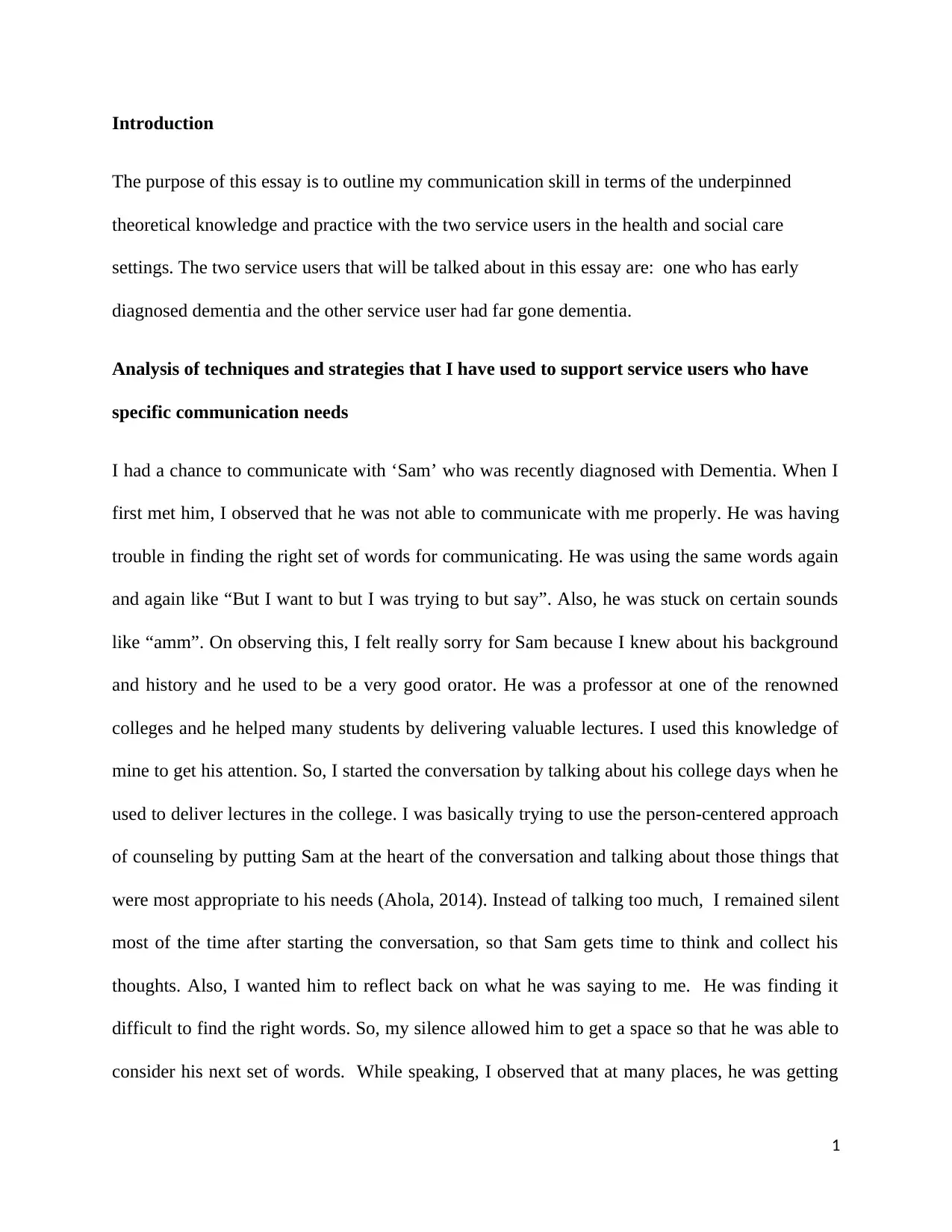
Introduction
The purpose of this essay is to outline my communication skill in terms of the underpinned
theoretical knowledge and practice with the two service users in the health and social care
settings. The two service users that will be talked about in this essay are: one who has early
diagnosed dementia and the other service user had far gone dementia.
Analysis of techniques and strategies that I have used to support service users who have
specific communication needs
I had a chance to communicate with ‘Sam’ who was recently diagnosed with Dementia. When I
first met him, I observed that he was not able to communicate with me properly. He was having
trouble in finding the right set of words for communicating. He was using the same words again
and again like “But I want to but I was trying to but say”. Also, he was stuck on certain sounds
like “amm”. On observing this, I felt really sorry for Sam because I knew about his background
and history and he used to be a very good orator. He was a professor at one of the renowned
colleges and he helped many students by delivering valuable lectures. I used this knowledge of
mine to get his attention. So, I started the conversation by talking about his college days when he
used to deliver lectures in the college. I was basically trying to use the person-centered approach
of counseling by putting Sam at the heart of the conversation and talking about those things that
were most appropriate to his needs (Ahola, 2014). Instead of talking too much, I remained silent
most of the time after starting the conversation, so that Sam gets time to think and collect his
thoughts. Also, I wanted him to reflect back on what he was saying to me. He was finding it
difficult to find the right words. So, my silence allowed him to get a space so that he was able to
consider his next set of words. While speaking, I observed that at many places, he was getting
1
The purpose of this essay is to outline my communication skill in terms of the underpinned
theoretical knowledge and practice with the two service users in the health and social care
settings. The two service users that will be talked about in this essay are: one who has early
diagnosed dementia and the other service user had far gone dementia.
Analysis of techniques and strategies that I have used to support service users who have
specific communication needs
I had a chance to communicate with ‘Sam’ who was recently diagnosed with Dementia. When I
first met him, I observed that he was not able to communicate with me properly. He was having
trouble in finding the right set of words for communicating. He was using the same words again
and again like “But I want to but I was trying to but say”. Also, he was stuck on certain sounds
like “amm”. On observing this, I felt really sorry for Sam because I knew about his background
and history and he used to be a very good orator. He was a professor at one of the renowned
colleges and he helped many students by delivering valuable lectures. I used this knowledge of
mine to get his attention. So, I started the conversation by talking about his college days when he
used to deliver lectures in the college. I was basically trying to use the person-centered approach
of counseling by putting Sam at the heart of the conversation and talking about those things that
were most appropriate to his needs (Ahola, 2014). Instead of talking too much, I remained silent
most of the time after starting the conversation, so that Sam gets time to think and collect his
thoughts. Also, I wanted him to reflect back on what he was saying to me. He was finding it
difficult to find the right words. So, my silence allowed him to get a space so that he was able to
consider his next set of words. While speaking, I observed that at many places, he was getting
1
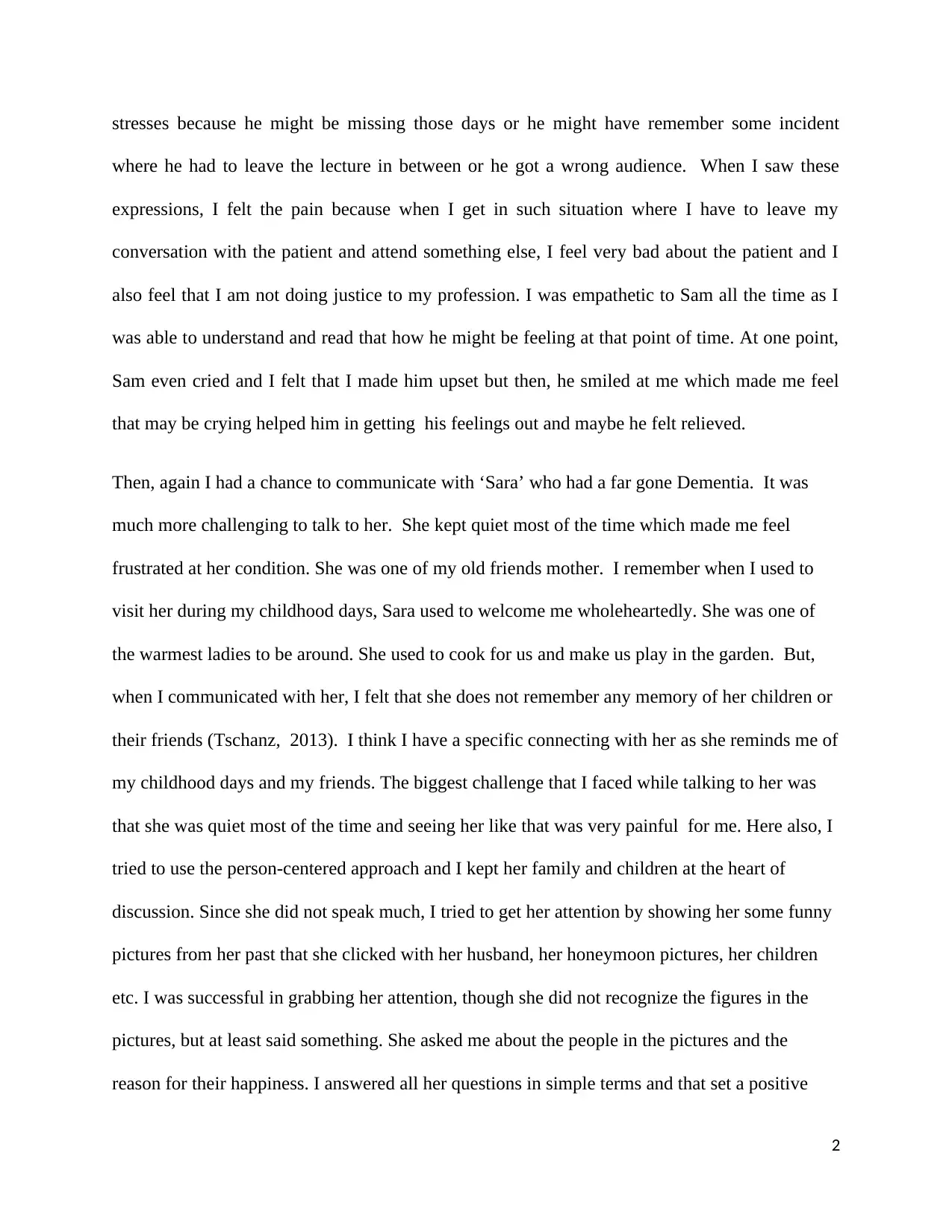
stresses because he might be missing those days or he might have remember some incident
where he had to leave the lecture in between or he got a wrong audience. When I saw these
expressions, I felt the pain because when I get in such situation where I have to leave my
conversation with the patient and attend something else, I feel very bad about the patient and I
also feel that I am not doing justice to my profession. I was empathetic to Sam all the time as I
was able to understand and read that how he might be feeling at that point of time. At one point,
Sam even cried and I felt that I made him upset but then, he smiled at me which made me feel
that may be crying helped him in getting his feelings out and maybe he felt relieved.
Then, again I had a chance to communicate with ‘Sara’ who had a far gone Dementia. It was
much more challenging to talk to her. She kept quiet most of the time which made me feel
frustrated at her condition. She was one of my old friends mother. I remember when I used to
visit her during my childhood days, Sara used to welcome me wholeheartedly. She was one of
the warmest ladies to be around. She used to cook for us and make us play in the garden. But,
when I communicated with her, I felt that she does not remember any memory of her children or
their friends (Tschanz, 2013). I think I have a specific connecting with her as she reminds me of
my childhood days and my friends. The biggest challenge that I faced while talking to her was
that she was quiet most of the time and seeing her like that was very painful for me. Here also, I
tried to use the person-centered approach and I kept her family and children at the heart of
discussion. Since she did not speak much, I tried to get her attention by showing her some funny
pictures from her past that she clicked with her husband, her honeymoon pictures, her children
etc. I was successful in grabbing her attention, though she did not recognize the figures in the
pictures, but at least said something. She asked me about the people in the pictures and the
reason for their happiness. I answered all her questions in simple terms and that set a positive
2
where he had to leave the lecture in between or he got a wrong audience. When I saw these
expressions, I felt the pain because when I get in such situation where I have to leave my
conversation with the patient and attend something else, I feel very bad about the patient and I
also feel that I am not doing justice to my profession. I was empathetic to Sam all the time as I
was able to understand and read that how he might be feeling at that point of time. At one point,
Sam even cried and I felt that I made him upset but then, he smiled at me which made me feel
that may be crying helped him in getting his feelings out and maybe he felt relieved.
Then, again I had a chance to communicate with ‘Sara’ who had a far gone Dementia. It was
much more challenging to talk to her. She kept quiet most of the time which made me feel
frustrated at her condition. She was one of my old friends mother. I remember when I used to
visit her during my childhood days, Sara used to welcome me wholeheartedly. She was one of
the warmest ladies to be around. She used to cook for us and make us play in the garden. But,
when I communicated with her, I felt that she does not remember any memory of her children or
their friends (Tschanz, 2013). I think I have a specific connecting with her as she reminds me of
my childhood days and my friends. The biggest challenge that I faced while talking to her was
that she was quiet most of the time and seeing her like that was very painful for me. Here also, I
tried to use the person-centered approach and I kept her family and children at the heart of
discussion. Since she did not speak much, I tried to get her attention by showing her some funny
pictures from her past that she clicked with her husband, her honeymoon pictures, her children
etc. I was successful in grabbing her attention, though she did not recognize the figures in the
pictures, but at least said something. She asked me about the people in the pictures and the
reason for their happiness. I answered all her questions in simple terms and that set a positive
2
⊘ This is a preview!⊘
Do you want full access?
Subscribe today to unlock all pages.

Trusted by 1+ million students worldwide
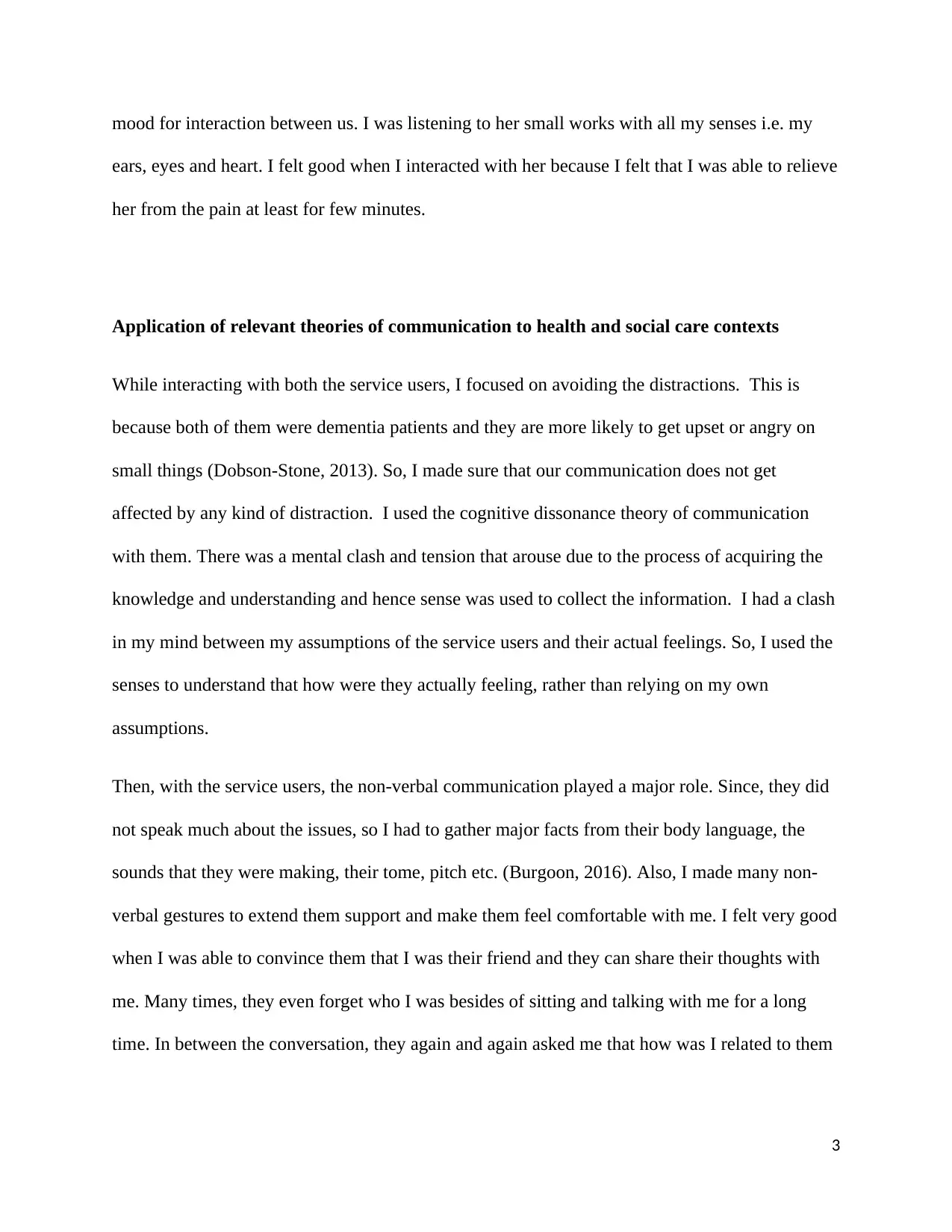
mood for interaction between us. I was listening to her small works with all my senses i.e. my
ears, eyes and heart. I felt good when I interacted with her because I felt that I was able to relieve
her from the pain at least for few minutes.
Application of relevant theories of communication to health and social care contexts
While interacting with both the service users, I focused on avoiding the distractions. This is
because both of them were dementia patients and they are more likely to get upset or angry on
small things (Dobson-Stone, 2013). So, I made sure that our communication does not get
affected by any kind of distraction. I used the cognitive dissonance theory of communication
with them. There was a mental clash and tension that arouse due to the process of acquiring the
knowledge and understanding and hence sense was used to collect the information. I had a clash
in my mind between my assumptions of the service users and their actual feelings. So, I used the
senses to understand that how were they actually feeling, rather than relying on my own
assumptions.
Then, with the service users, the non-verbal communication played a major role. Since, they did
not speak much about the issues, so I had to gather major facts from their body language, the
sounds that they were making, their tome, pitch etc. (Burgoon, 2016). Also, I made many non-
verbal gestures to extend them support and make them feel comfortable with me. I felt very good
when I was able to convince them that I was their friend and they can share their thoughts with
me. Many times, they even forget who I was besides of sitting and talking with me for a long
time. In between the conversation, they again and again asked me that how was I related to them
3
ears, eyes and heart. I felt good when I interacted with her because I felt that I was able to relieve
her from the pain at least for few minutes.
Application of relevant theories of communication to health and social care contexts
While interacting with both the service users, I focused on avoiding the distractions. This is
because both of them were dementia patients and they are more likely to get upset or angry on
small things (Dobson-Stone, 2013). So, I made sure that our communication does not get
affected by any kind of distraction. I used the cognitive dissonance theory of communication
with them. There was a mental clash and tension that arouse due to the process of acquiring the
knowledge and understanding and hence sense was used to collect the information. I had a clash
in my mind between my assumptions of the service users and their actual feelings. So, I used the
senses to understand that how were they actually feeling, rather than relying on my own
assumptions.
Then, with the service users, the non-verbal communication played a major role. Since, they did
not speak much about the issues, so I had to gather major facts from their body language, the
sounds that they were making, their tome, pitch etc. (Burgoon, 2016). Also, I made many non-
verbal gestures to extend them support and make them feel comfortable with me. I felt very good
when I was able to convince them that I was their friend and they can share their thoughts with
me. Many times, they even forget who I was besides of sitting and talking with me for a long
time. In between the conversation, they again and again asked me that how was I related to them
3
Paraphrase This Document
Need a fresh take? Get an instant paraphrase of this document with our AI Paraphraser
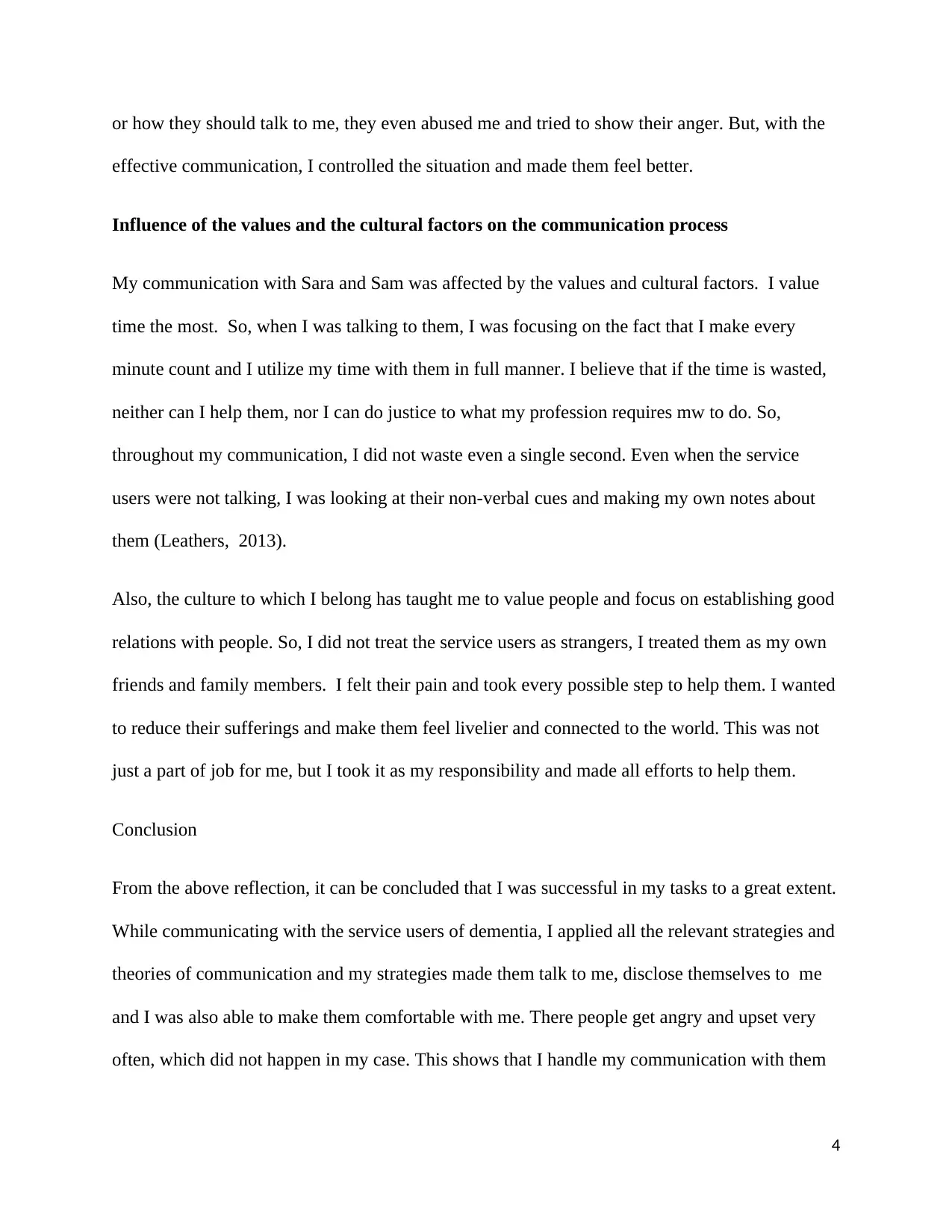
or how they should talk to me, they even abused me and tried to show their anger. But, with the
effective communication, I controlled the situation and made them feel better.
Influence of the values and the cultural factors on the communication process
My communication with Sara and Sam was affected by the values and cultural factors. I value
time the most. So, when I was talking to them, I was focusing on the fact that I make every
minute count and I utilize my time with them in full manner. I believe that if the time is wasted,
neither can I help them, nor I can do justice to what my profession requires mw to do. So,
throughout my communication, I did not waste even a single second. Even when the service
users were not talking, I was looking at their non-verbal cues and making my own notes about
them (Leathers, 2013).
Also, the culture to which I belong has taught me to value people and focus on establishing good
relations with people. So, I did not treat the service users as strangers, I treated them as my own
friends and family members. I felt their pain and took every possible step to help them. I wanted
to reduce their sufferings and make them feel livelier and connected to the world. This was not
just a part of job for me, but I took it as my responsibility and made all efforts to help them.
Conclusion
From the above reflection, it can be concluded that I was successful in my tasks to a great extent.
While communicating with the service users of dementia, I applied all the relevant strategies and
theories of communication and my strategies made them talk to me, disclose themselves to me
and I was also able to make them comfortable with me. There people get angry and upset very
often, which did not happen in my case. This shows that I handle my communication with them
4
effective communication, I controlled the situation and made them feel better.
Influence of the values and the cultural factors on the communication process
My communication with Sara and Sam was affected by the values and cultural factors. I value
time the most. So, when I was talking to them, I was focusing on the fact that I make every
minute count and I utilize my time with them in full manner. I believe that if the time is wasted,
neither can I help them, nor I can do justice to what my profession requires mw to do. So,
throughout my communication, I did not waste even a single second. Even when the service
users were not talking, I was looking at their non-verbal cues and making my own notes about
them (Leathers, 2013).
Also, the culture to which I belong has taught me to value people and focus on establishing good
relations with people. So, I did not treat the service users as strangers, I treated them as my own
friends and family members. I felt their pain and took every possible step to help them. I wanted
to reduce their sufferings and make them feel livelier and connected to the world. This was not
just a part of job for me, but I took it as my responsibility and made all efforts to help them.
Conclusion
From the above reflection, it can be concluded that I was successful in my tasks to a great extent.
While communicating with the service users of dementia, I applied all the relevant strategies and
theories of communication and my strategies made them talk to me, disclose themselves to me
and I was also able to make them comfortable with me. There people get angry and upset very
often, which did not happen in my case. This shows that I handle my communication with them
4

in a good way and my communication was effective too. Lastly, the culture and values to which I
belong have impacted the way in which I talk to the people and the service users.
5
belong have impacted the way in which I talk to the people and the service users.
5
⊘ This is a preview!⊘
Do you want full access?
Subscribe today to unlock all pages.

Trusted by 1+ million students worldwide
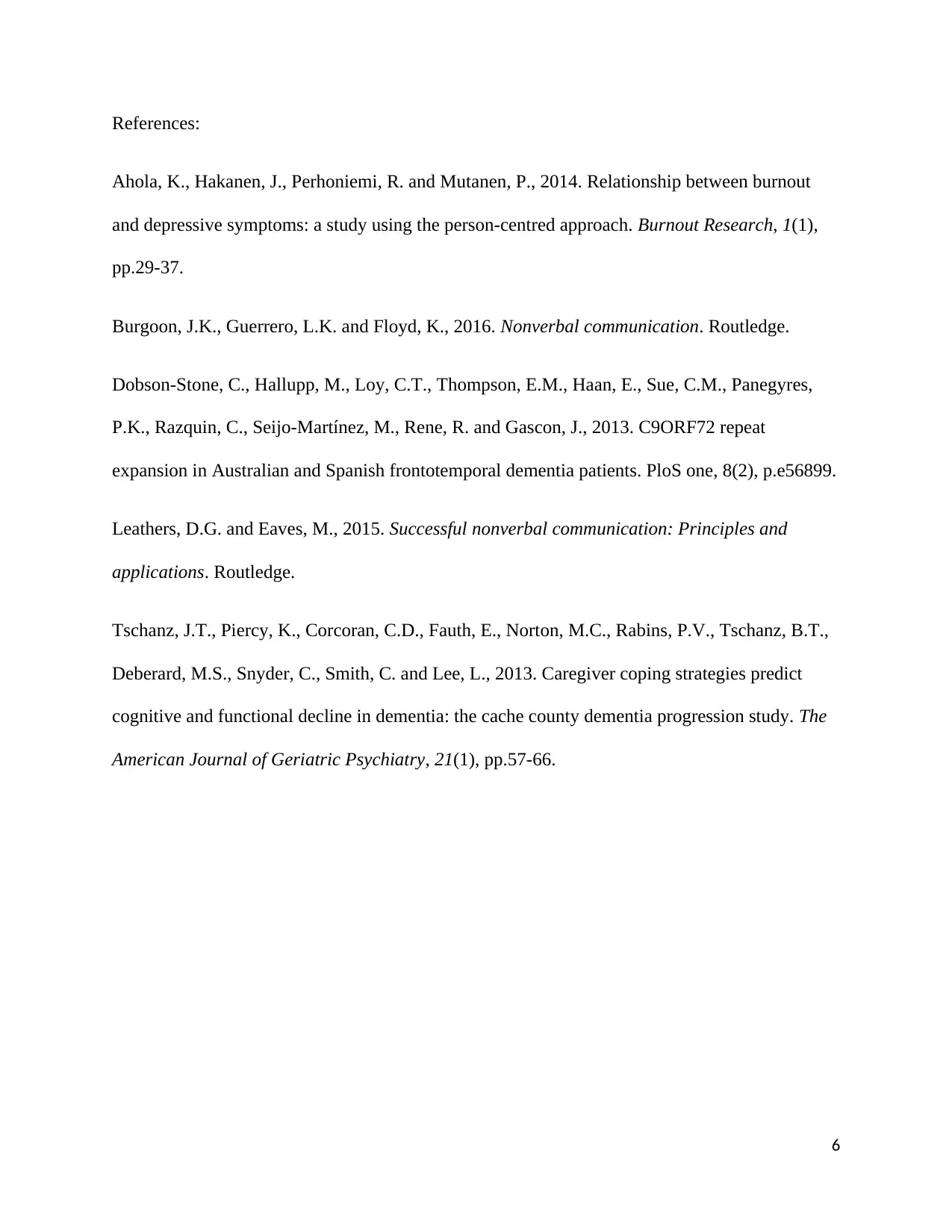
References:
Ahola, K., Hakanen, J., Perhoniemi, R. and Mutanen, P., 2014. Relationship between burnout
and depressive symptoms: a study using the person-centred approach. Burnout Research, 1(1),
pp.29-37.
Burgoon, J.K., Guerrero, L.K. and Floyd, K., 2016. Nonverbal communication. Routledge.
Dobson-Stone, C., Hallupp, M., Loy, C.T., Thompson, E.M., Haan, E., Sue, C.M., Panegyres,
P.K., Razquin, C., Seijo-Martínez, M., Rene, R. and Gascon, J., 2013. C9ORF72 repeat
expansion in Australian and Spanish frontotemporal dementia patients. PloS one, 8(2), p.e56899.
Leathers, D.G. and Eaves, M., 2015. Successful nonverbal communication: Principles and
applications. Routledge.
Tschanz, J.T., Piercy, K., Corcoran, C.D., Fauth, E., Norton, M.C., Rabins, P.V., Tschanz, B.T.,
Deberard, M.S., Snyder, C., Smith, C. and Lee, L., 2013. Caregiver coping strategies predict
cognitive and functional decline in dementia: the cache county dementia progression study. The
American Journal of Geriatric Psychiatry, 21(1), pp.57-66.
6
Ahola, K., Hakanen, J., Perhoniemi, R. and Mutanen, P., 2014. Relationship between burnout
and depressive symptoms: a study using the person-centred approach. Burnout Research, 1(1),
pp.29-37.
Burgoon, J.K., Guerrero, L.K. and Floyd, K., 2016. Nonverbal communication. Routledge.
Dobson-Stone, C., Hallupp, M., Loy, C.T., Thompson, E.M., Haan, E., Sue, C.M., Panegyres,
P.K., Razquin, C., Seijo-Martínez, M., Rene, R. and Gascon, J., 2013. C9ORF72 repeat
expansion in Australian and Spanish frontotemporal dementia patients. PloS one, 8(2), p.e56899.
Leathers, D.G. and Eaves, M., 2015. Successful nonverbal communication: Principles and
applications. Routledge.
Tschanz, J.T., Piercy, K., Corcoran, C.D., Fauth, E., Norton, M.C., Rabins, P.V., Tschanz, B.T.,
Deberard, M.S., Snyder, C., Smith, C. and Lee, L., 2013. Caregiver coping strategies predict
cognitive and functional decline in dementia: the cache county dementia progression study. The
American Journal of Geriatric Psychiatry, 21(1), pp.57-66.
6
1 out of 7
Related Documents
Your All-in-One AI-Powered Toolkit for Academic Success.
+13062052269
info@desklib.com
Available 24*7 on WhatsApp / Email
![[object Object]](/_next/static/media/star-bottom.7253800d.svg)
Unlock your academic potential
Copyright © 2020–2025 A2Z Services. All Rights Reserved. Developed and managed by ZUCOL.





